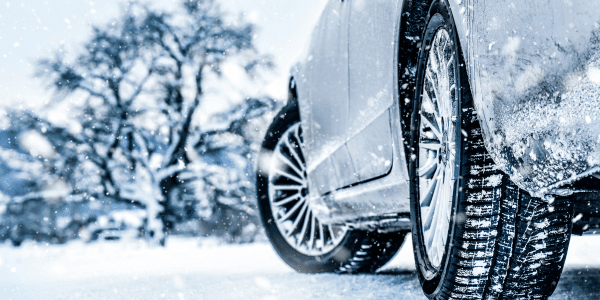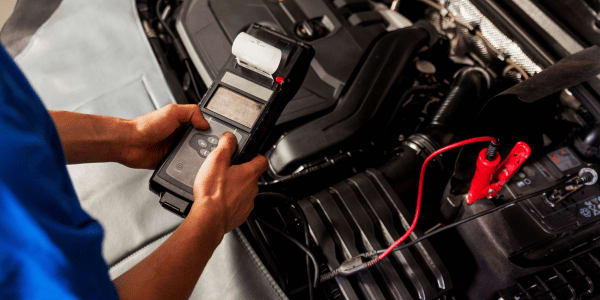Car Care: Get Your Car Prepped & Ready for Winter

Temperatures are dropping, and days are getting shorter. Now is the perfect time to give your car the attention it needs to handle the changing seasons ahead. From prepping for icy roads to ensuring your battery can keep up with the cold, seasonal car maintenance is key to staying safe and avoiding unexpected issues. Here are the top winter car maintenance items you should address to keep your vehicle running smoothly all season long.
Winter Car Maintenance Checklist
Winter car maintenance is a bit different from fall and summer car maintenance. Preparing your car for the season may be as simple as changing the oil, but some cars may need more extensive work. Fortunately, we have the ultimate seasonal car maintenance checklist right here. Follow along as we explore every major aspect of your car and what it needs for winter.
Winter Car Tire Maintenance
Fall rain and snow can create dangerous roads. Curb any problems by making sure your tires have sufficient tread (the rubber that touches the road) and proper inflation. To check the tread, place a penny between your tire’s grooves, with the head side upside down and facing you. If you can see all of Abraham Lincoln’s head, your tread depth is low, and your tires may need to be replaced. When it comes to tire pressure, tires typically require 32 to 35 pounds per square inch (psi) of air; you can find the exact specs on a sticker inside the driver’s door or in your owner’s manual. You should use a gauge for the most accurate reading, but a quick glance or feel can also give you an idea of your tires’ state.
Winter Car Brake Maintenance
Enabling your vehicle to stop or slow down, your car’s brake system might be the most important part of its operation—especially with wet winter elements right around the corner. Inspect your brake pads by looking into your car’s wheel. A small portion of the brake pad should be visible on the edge of the inner circle of your wheel. If you hear squealing or grinding when you drive, feel veering and vibrations, or can’t see more than three millimeters of the outer pad, get a professional inspection.

Winter Car Battery Maintenance
Your car battery gives your vehicle the power to start, and cold weather can make the job of this crucial component pretty tricky. While most auto parts stores will test your battery’s electrical output for free, you can also purchase a battery tester to check your voltage and the status of your starter and alternator. Look for a buildup of debris or corrosion on or around the terminals where chargers are hooked up, too. If anything needs to be cleaned, disconnect your negative and positive cables correctly, and remove debris using a wire brush and battery cleaning solution.
Winter Car Headlights Maintenance
With shorter days and darker nights, you’ll probably use your headlights often. To guarantee your headlights are good to go, turn on your car and switch on your lights, checking the brightness and clarity against a garage door or other surface. Headlight covers that are clear should be fine for continued use. To restore hazy lights, you can purchase a DIY cleaning kit and, with a little bit of elbow grease, get things back to shining bright. But if you notice issues within the lightbulbs, like gray or brown buildup, you may need major repairs. Examine your interior lights for blown fuses or shorts, and don’t hesitate to consult the experts to avoid electrical hazards.
Read More: Garage Dos and Don’ts
Winter Car Oil, Filters, & Gasoline Maintenance
When temperatures drop, oil thickens and can stress your engine. Stay up to date on your oil changes, getting one every 3,000 to 10,000 miles or every three months, depending on how much you drive and the type of car you have. Additionally, replace your cabin filters so warm air can flow freely, and keep your gas tank filled at least halfway so the liquid doesn’t freeze.
Winter Car Windshield Wiper Fluid & Windshield Wiper Maintenance
Windshield wipers must be in tip-top shape to wash away the grime left behind by falling leaves or wind. Replace cracked, worn, or streaking wipers ASAP, and confirm you have enough windshield wiper fluid. If you need a refill, the process is simple:
How to Change Windshield Wiper Fluid
- Buy windshield wiper fluid.
- Pop open the hood of your car.
- Locate the plastic reservoir that says “windshield” or has a water-spraying symbol and unscrew the cap.
- Pour the fluid into the container until it reaches “full” or “max.”
- Put the cap back on and close your hood.
Beyond Winter Car Maintenance: More Seasonal Maintenance Solutions
Winter car maintenance is vital, but your vehicle isn’t the only thing you should be prioritizing when it comes to seasonal care. Your home deserves just as much preparation for changing weather, and we’re here to help you get it ready. With our “Winter Home Maintenance Checklist,” you can ensure your home—just like your car—is all set for the elements that come in November, December, and January.
